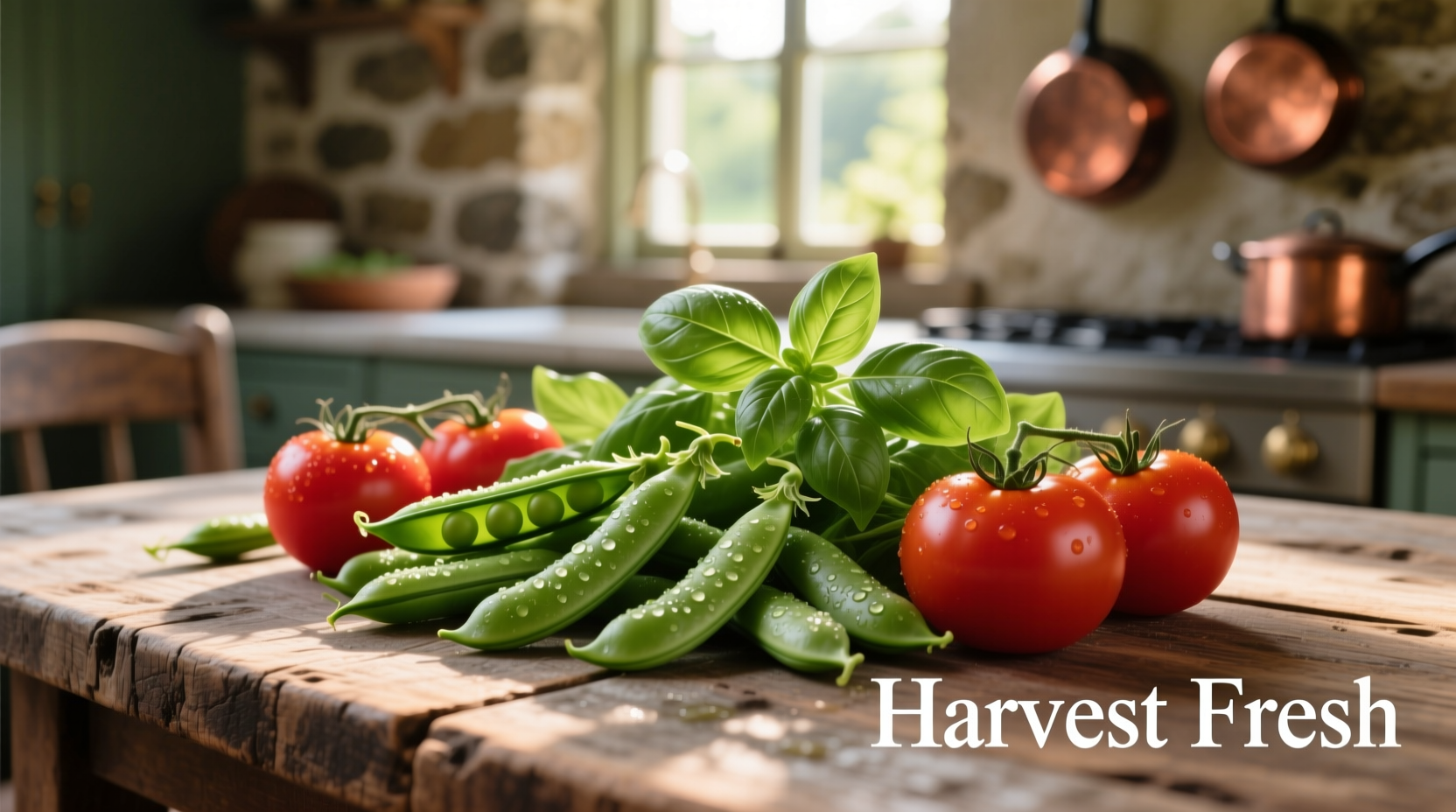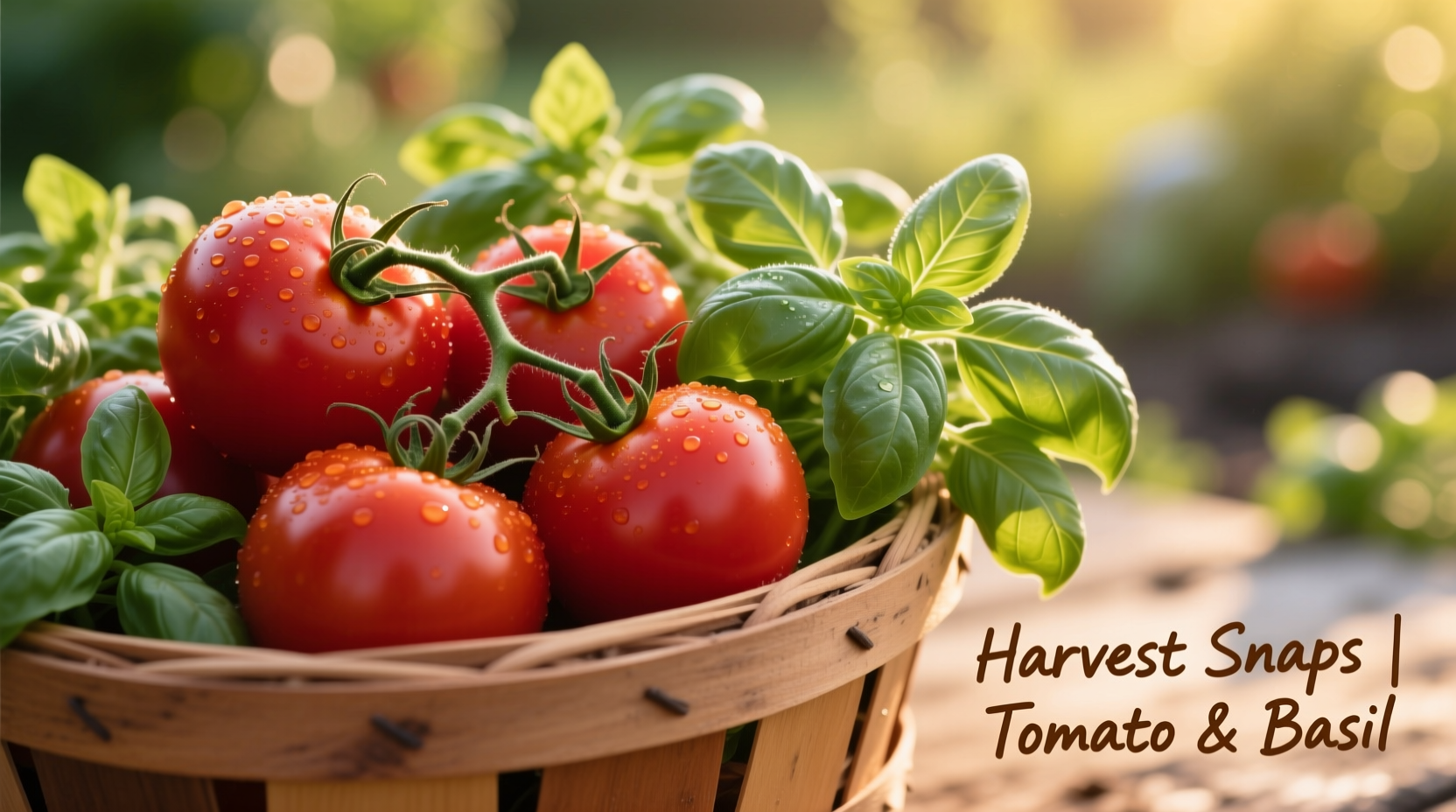Harvest snaps, tomatoes, and basil together for peak flavor and garden productivity. Snap peas reach harvest readiness 55-70 days after planting when pods are bright green and plump. Tomatoes should be fully colored but still firm, while basil leaves are best picked before flowering when essential oils peak. These three plants thrive as companions—basil deters pests from tomatoes, while snap peas fix nitrogen benefiting both.
There's nothing quite like the taste of garden-fresh snap peas, tomatoes, and basil harvested at their precise moment of perfection. Many home gardeners struggle with timing their harvests correctly or understanding how these three popular crops interact when grown together. Getting the harvest timing right makes the difference between stringy peas, mealy tomatoes, and bitter basil versus crisp, sweet, and aromatic garden treasures.
Understanding Your Harvest Timeline
Successful harvesting starts with understanding each plant's growth cycle. Snap peas mature fastest, tomatoes take the longest, and basil falls somewhere in between. This natural progression creates perfect opportunities for succession harvesting throughout the season.
| Plant | Days to Maturity | Harvest Window | Peak Season |
|---|---|---|---|
| Snap Peas | 55-70 days | 7-10 days | Early summer |
| Tomatoes | 60-85 days | 6-8 weeks | Mid to late summer |
| Basil | 60-70 days | 3-4 months | Throughout summer |
This timeline from the University of Minnesota Extension shows why these plants work well together in your garden rotation. As your snap peas finish producing, your tomatoes are hitting their stride, with basil providing continuous harvest throughout.
Perfect Harvest Indicators
Knowing exactly when to pick each crop ensures maximum flavor and encourages continued production:
Snap Peas
- Pods should be bright green, plump, and nearly cylindrical
- Pea shape should be clearly visible through the pod
- Harvest in the morning after dew has dried for best crispness
- Use two hands to avoid damaging the vine
Tomatoes
- Pick when fully colored but still firm to the touch
- Slight give when gently squeezed indicates ripeness
- Harvest before fruit becomes overly soft
- Twist fruit upward to detach from the vine
Basil
- Harvest before flowering for strongest flavor
- Pick leaves in the morning when essential oils peak
- Take no more than one-third of the plant at once
- Cut just above leaf nodes to encourage bushier growth

Companion Planting Benefits
These three plants form an ideal garden partnership. According to research from Oregon State University Extension, basil planted near tomatoes reduces thrips and whiteflies by up to 30% while improving tomato flavor compounds. Snap peas, as legumes, fix nitrogen in the soil, benefiting both tomatoes and basil.
When planning your garden layout:
- Plant snap peas on the north side to avoid shading other plants
- Position tomatoes where they'll receive full sun all day
- Place basil between tomatoes as a living mulch to retain moisture
- Maintain 12-18 inches between plants for proper air circulation
Harvesting Techniques That Maximize Production
How you harvest affects future yields. For snap peas, regular picking every 1-2 days encourages more production. Tomatoes benefit from being harvested slightly underripe in hot weather and allowed to finish ripening indoors. With basil, always cut above leaf nodes to stimulate branching.
The USDA Plant Database confirms that proper harvesting techniques can extend your productive season by 3-4 weeks for snap peas and tomatoes, while basil can produce continuously with correct harvesting methods.
Post-Harvest Handling for Maximum Freshness
What you do after harvesting determines how long your produce stays fresh:
- Snap peas: Store unwashed in perforated plastic bags in the crisper drawer (3-5 days)
- Tomatoes: Keep at room temperature away from direct sunlight (5-7 days)
- Basil: Treat like cut flowers—trim stems and place in water at room temperature (7-10 days)
Never refrigerate tomatoes or basil immediately after harvest, as cold temperatures destroy flavor compounds and cause texture issues. Snap peas are the exception—they benefit from quick refrigeration.
Simple Ways to Enjoy Your Harvest
The magic of harvesting these three together is how perfectly they complement each other in the kitchen. Try these simple preparations:
- Blistered snap peas: Toss with olive oil and sea salt, then roast at 425°F for 12-15 minutes
- Tomato-basil bruschetta: Combine diced tomatoes, minced basil, garlic, and balsamic vinegar on toasted bread
- Snap pea and tomato salad: Toss sliced snap peas with cherry tomatoes, fresh basil, and lemon vinaigrette
According to flavor chemistry research from the USDA Agricultural Research Service, the volatile compounds in freshly harvested basil interact with tomato acids to create more complex flavor profiles than when using store-bought ingredients.
Troubleshooting Common Harvest Issues
Even experienced gardeners encounter challenges. Here's how to handle common problems:
- Stringy snap peas: Harvest earlier next time—peas become fibrous when left on the vine too long
- Cracking tomatoes: Maintain consistent watering, especially during dry spells followed by rain
- Bitter basil: Harvest before flowering and avoid letting plants become root-bound
- Reduced yields: Ensure proper spacing and regular harvesting to encourage continued production
Remember that environmental factors significantly impact harvest quality. The Oregon State University Extension notes that temperature fluctuations of more than 20°F between day and night can reduce snap pea quality by up to 40%, while tomatoes develop best flavor when daytime temperatures stay between 70-85°F.











 浙公网安备
33010002000092号
浙公网安备
33010002000092号 浙B2-20120091-4
浙B2-20120091-4